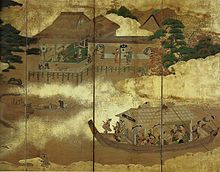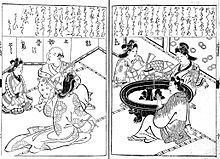Hishikawa Moronobu
Hishikawa Moronobu ( Japanese 菱 川 師 宣 ; * 1618 in Hota , Heguri-gun , Awa Province (today: Kyonan , Awa-gun , Chiba Prefecture ); † July 25, 1694 ) was a Japanese painter and graphic artist . He is considered to be the first great master of Japanese woodcut and the founder of the ukiyo-e style.
biography
Hishikawa Moronobu, son of the picture sticker Hishikawa Kichizeiemon Michishige, was born in Hota into a family that produced lavishly decorated fabrics. Interested in painting at an early age, he went to Edo at the age of 16, studied the Tosa and Hasegawa School painting style and began to illustrate books without having a teacher.
In 1672 a work was published Buke hyakunin isshu ( 武 家 百 人 一 erschien ) with signed woodcuts by him. This was the first time that illustrations with the artist's name appeared. He quickly became a well-known artist in Edo, and other books followed, including Ukiyo hyakunin bijin ( 浮世 百 人 美女 ), Ukiyo tsuzuki ( 浮世 続 ), Bijin-e zukushi ( 美人 絵 づ く し ). Overall, he is said to have provided illustrations for over a hundred books on wars, adventures and occasionally for travel guides. He also illustrated over fifty books with erotic content ( 好色 本 , kōshoku-bon ) such as various pillow books (such as Yoshiwara-mukura and Yoshiwara kagami , around 1660) and the woodcut book Koi no Tanoshimi published in 1683 , but also simple readings for women and children ( か な 草紙 , kana zōshi ).
Hishikawa published subjects from his book illustrations as larger "single-sheet prints" ( ichimai-e ), which appeared as sets of several sheets and which can be considered the beginning of Ukiyo-e. His pictures show a simple, strong line. The composition of the image was based on the Yamato-e with its 45 degree perspective.
In addition to the prints in black and white (sometimes hand-colored), Hishikawa created wall screens , picture scrolls and hanging scrolls .
His work was continued by his sons Morofusa ( 師 房 ) and Moronaga ( 師 永 ) (adopted, husband of his daughter) as well as by his students Moroshige ( 師 重 ), Tomofusa ( 友 房 ), Morohira ( 師 平 ) and others.
plant
Wall screens (selection)
- Sumidagawa / Ueno fuzoku byōbu ( 隅田川 ・ 上 野 風俗 屏風 )
Paintings (selection)
- Mikaeri bijin zu ( 見 返 り 美人 図 ) Tokyo National Museum
- Tachi bijin to ( 立 美人 図 )
Scrolls (selection)
- Edo fūzoku e-maki ( 江 戸 風俗 絵 巻 ) 39.1 × 903.7 cm, MOA Art Museum
- Hokurō ( Yoshiwara ) oyobi engki zukan ( 北 楼 及 び 演劇 図 巻 ) 32.1 × 697.0 cm, Tokyo National Museum
- Ōeyama-oni taiji emaki ( 大江 山鬼 退 治 絵 巻 ) Three scrolls, Fujita Art Museum
Print series (selection)
- Yoshiwara no tei ( 吉 原 の 躰 )
- Edo butsusan no tei ( 江 戸 物 参 の 躰 )
- Ueno hanami no tei ( 上 野花 見 の 躰 )
- Tsuitate no kage ( 衝 立 の か げ )
literature
- Chiba Museum of Art (Ed.): Hishikawa Moronobu Exhibition , 2000.
- Inagaki Shin'ichi: Ukiyoe nyūmon . Kawade Shobo Shinsha, 1990. ISBN 4-309-72476-0 .
- Tazawa Yutaka: Bibliographical dictionary of Japanese Art . Kodansha International, 1981. ISBN 0-87011-488-3 .
Web links
Individual evidence
- ^ Franz Winzinger: Koi no Tanoshimi. Epilogue. In: amusements of love. 1988, pp. 39-45.
- ↑ Hishikawa Moronobu: Pleasures of Love. Koi no Tanoshimi. With explanations by Franz Winzinger, Harenberg Kommunikation, Dortmund 1979, 4th edition ibid. 1988 (= The bibliophile paperbacks. Volume 128).
| personal data | |
|---|---|
| SURNAME | Hishikawa, Moronobu |
| ALTERNATIVE NAMES | 菱 川 師 宣 (Japanese) |
| BRIEF DESCRIPTION | Japanese painter and graphic artist |
| DATE OF BIRTH | uncertain: 1618 |
| PLACE OF BIRTH | Hota , Heguri-gun , Awa Province (today: Kyonan , Awa-gun , Chiba Prefecture ) |
| DATE OF DEATH | July 25, 1694 |




